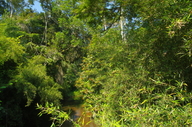|
Description
A large frog with a variable colouration; males 50-70 mm, females
75-87 mm, maximum length 100 mm. Colouration varies from being almost entirely
blackish to yellowish with black spots. Venter yellowish or orange, with or
without blackish spots. Iris copper, iris periphery turquoise. Skin on the back
smooth in females, granular in males during the breeding season. Iris copper, iris periphery turquoise. Nostrils nearer
to eye than to tip of snout. Tympanum distinct, about 1/2 - 2/3 of eye diameter.
Tibiotarsal articulation reaches at least the nostrils, sometimes beyond the
tip of the snout. Webbing of the hand 1(1), 2i/e(1), 3i(2), 3e(1.5), 4(1); webbing
of the foot 1(0), 2i(1), 2e(0), 3i(1), 3e(0), 4i/e (1-1.5), 5 (0.5). Males with
nuptial pads and a slightly distensible, single subgular vocal sac.
Similar species: Boophis madagascariensis and B. brachychir have dermal flaps on the
elbow and heel; the hands of B. opisthodon are not webbed, B.
albilabris is often green with well developed webbing between the fingers.
Distribution and Habitat
Country distribution from AmphibiaWeb's database: Madagascar
Ambatolampy, Ambohimitombo, Ambohitantely, Ambositra, Andasibe, Andrangoloaka, Andranomay forest, Angavokely, Anosibe, Antananarivo, Antratrabe, Antsampandrano, Beanjombona, Beforona, Betafo, Ibity, Itremo, Mandraka, Manjakatompo, Mantasoa, Moramanga, Niagarakely, Soamazaka, Tsiafajavona plateau, Tsinjoarivo, Vohisokina.
Observed between 900-2,200m asl. This species lives in rainforests, fields, and disturbed stream sides near slow-moving and stagnant water, rice fields, and degraded sites (Nussbaum et al. 2008).
Life History, Abundance, Activity, and Special Behaviors
A poor climber, but sometimes found in trees. During day and night in, or near, stagnant or slow-moving water in both forests and ricefields. When touched, specimens may inflate themselves. Both males and females call during day and night. Axillary amplexus was observed in August, and inguinal amplexus has also been reported.
Habits: Breeds in slow-moving and swampy stretches of sometimes very small streams. In rainforest or in deforested areas in the highlands with some gallery vegetation. Males call at night from hidden positions close to or in the water.
Calls: Irregularly emitted moaning notes.
Call (from Tsinjoarivo): The only Malagasy frog species for which female calls are reported. One analysed call of a male (recorded during amplexus) consisted of a series of 10 short "click"-notes, each lasting 20-30 ms, with a "click-rate" of about 30/s. Call was repeated at a rate of 60/min during about one minute. Dominant frequency ranged from 0.5 to 1 kHz. The female call is a low buzzing sound, repeated after intervals of about 7 s, with a duration about 500 ms and a frequency upto 1.5 kHz. One male emitted release calls when clasped.
Eggs and tadpoles:
Eggs were deposited in clumps of 30, attached to rocks and roots in water. Dissected females contained about 1000 eggs, 2 mm in diameter, coloured dark brown with cream. The brownish tadpoles live in slow-moving water and adjacent pools. Total length in stage 25: 31-61 mm; in stage 41: 73 mm. The mouth is small and directed ventrally. Eyes are directed dorsilaterally. At midlength of the tail, the caudal musculature represents about 1/4-3/10 of the total tail height. Tooth formula is 1/3+3//1+1/2 or 1/4+4//1+1/2. Metamorphosing juveniles can measure 30-32 mm from snout to vent. Their colour is brown or grey with irregular dark brown markings. The venter is yellowish, ventral hindlimb surface is orange. Limbs with distinct transverse bars. A triangular white spot is present both anteriorly and posteriorly of the tympanum.
Trends and Threats
Least Concern: wide distribution and tolerance of habitat modification. It occurs in many protected areas (Nussbaum et al. 2008). Comments
Taken with permission from Glaw and Vences (2007).
References
Glaw, F. and Vences, M. (1994). Amphibians and Reptiles of Madagascar. M. Vences and F. Glaw Verlags GbR., Köln.
Glaw, F., and Vences, M. (2007). Field Guide to the Amphibians and Reptiles of Madagascar. Third Edition. Vences and Glaw Verlag, Köln.
Nussbaum, R., Cadle, J., and Vallan, D. (2008). Boophis goudotii. In: IUCN 2008. 2008 IUCN Red List of Threatened Species. www.iucnredlist.org. Downloaded on 08 April 2009.
Originally submitted by: Miguel Vences and Frank Glaw (first posted 2000-10-30)
Edited by: Henry Zhu (2009-05-05)Species Account Citation: AmphibiaWeb 2009 Boophis goudotii <https://amphibiaweb.org/species/4341> University of California, Berkeley, CA, USA. Accessed Nov 21, 2024.
Feedback or comments about this page.
Citation: AmphibiaWeb. 2024. <https://amphibiaweb.org> University of California, Berkeley, CA, USA. Accessed 21 Nov 2024.
AmphibiaWeb's policy on data use.
|
